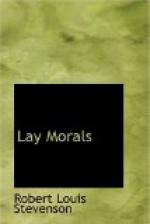CHAPTER III—BAGSTER’S ‘PILGRIM’S PROGRESS’
I have here before me an edition of the Pilgrim’s Progress, bound in green, without a date, and described as ’illustrated by nearly three hundred engravings, and memoir of Bunyan.’ On the outside it is lettered ‘Bagster’s Illustrated Edition,’ and after the author’s apology, facing the first page of the tale, a folding pictorial ‘Plan of the Road’ is marked as ‘drawn by the late Mr. T. Conder,’ and engraved by J. Basire. No further information is anywhere vouchsafed; perhaps the publishers had judged the work too unimportant; and we are still left ignorant whether or not we owe the woodcuts in the body of the volume to the same hand that drew the plan. It seems, however, more than probable. The literal particularity of mind which, in the map, laid down the flower-plots in the devil’s garden, and carefully introduced the court-house in the town of Vanity, is closely paralleled in many of the cuts; and in both, the architecture of the buildings and the disposition of the gardens have a kindred and entirely English air. Whoever he was, the author of these wonderful little pictures may lay claim to be the best illustrator of Bunyan. They are not only good illustrations, like so many others; but they are like so few, good illustrations of Bunyan. Their spirit, in defect and quality, is still the same as his own. The designer also has lain down and dreamed a dream, as literal, as quaint, and almost as apposite as Bunyan’s; and text and pictures make but the two sides of the same homespun yet impassioned story. To do justice to the designs, it will be necessary to say, for the hundredth time, a word or two about the masterpiece which they adorn.
All allegories have a tendency to escape from the purpose of their creators; and as the characters and incidents become more and more interesting in themselves, the moral, which these were to show forth, falls more and more into neglect. An architect may command a wreath of vine-leaves round the cornice of a monument; but if, as each leaf came from the chisel, it took proper life and fluttered freely on the wall, and if the vine grew, and the building were hidden over with foliage and fruit, the architect would stand in much the same situation as the writer of allegories. The Faery Queen was an allegory, I am willing to believe; but it survives as an imaginative tale in incomparable verse. The case of Bunyan is widely different; and yet in this also Allegory, poor nymph, although never quite forgotten, is sometimes rudely thrust against the wall. Bunyan was fervently in earnest; with ’his fingers in his ears, he ran on,’ straight for his mark. He tells us himself, in the conclusion to the first part, that he did not fear to raise a laugh; indeed, he feared nothing, and said anything; and he was greatly served in this by a certain rustic privilege of his style, which, like the talk of strong uneducated men, when




